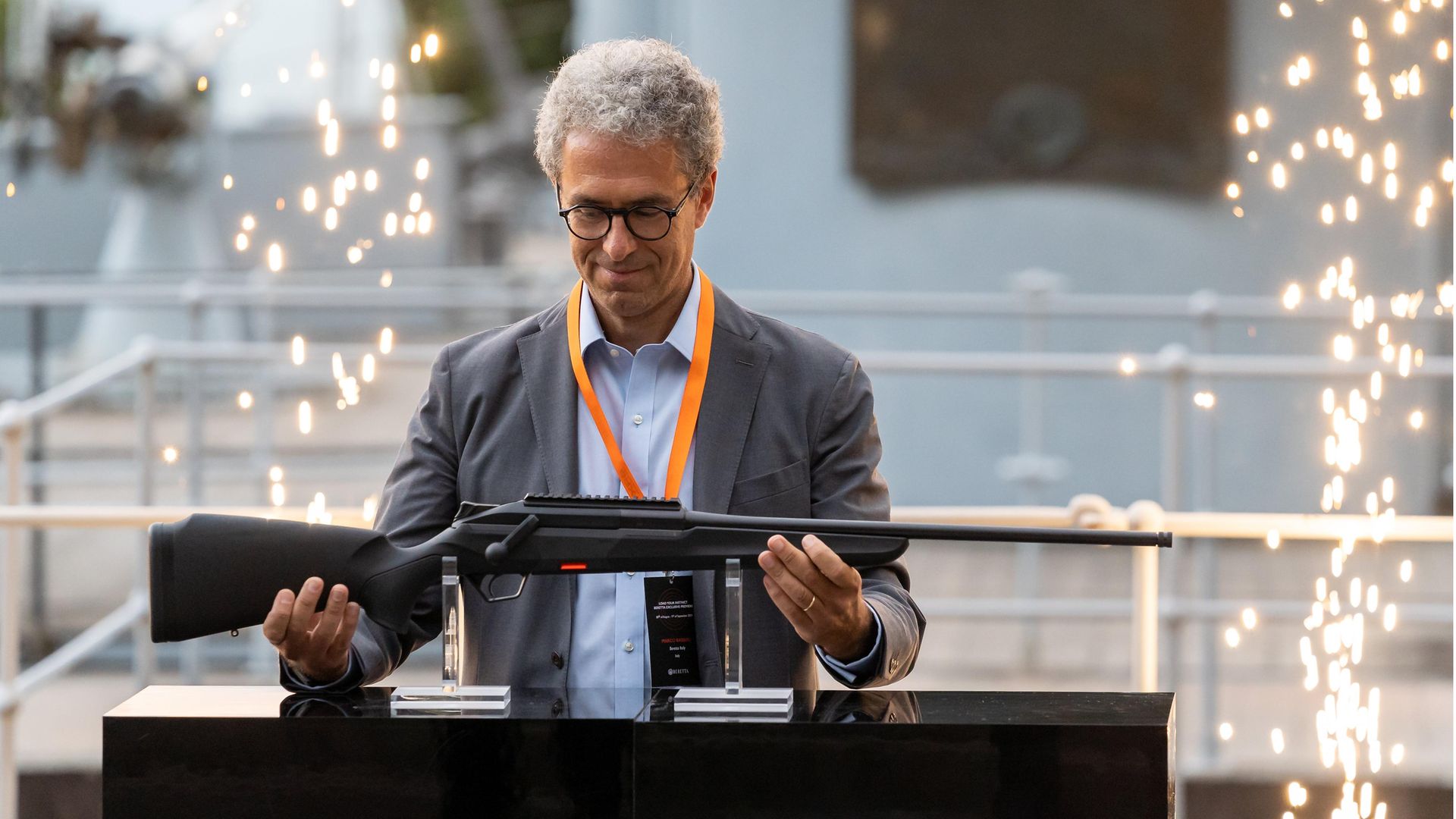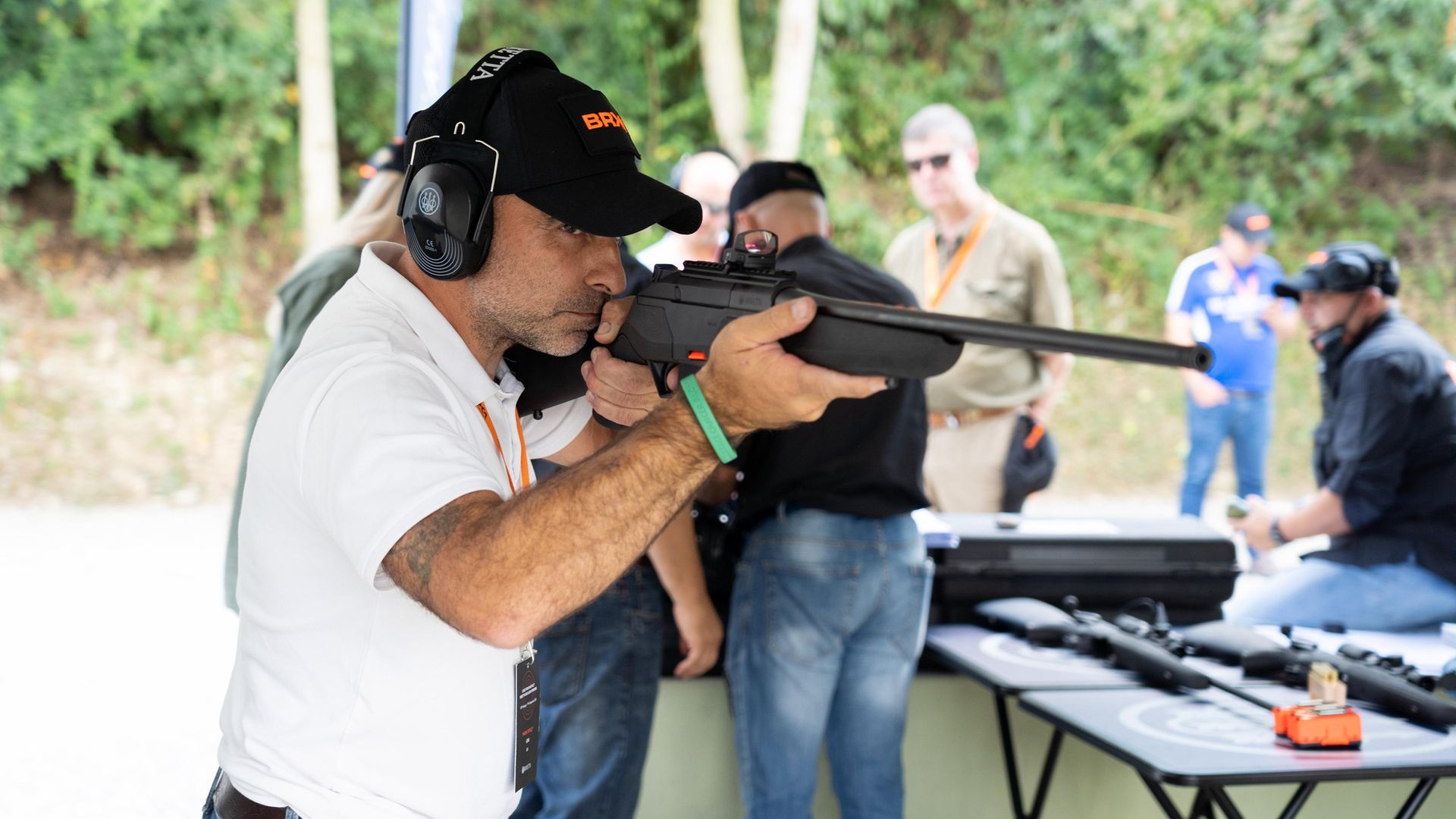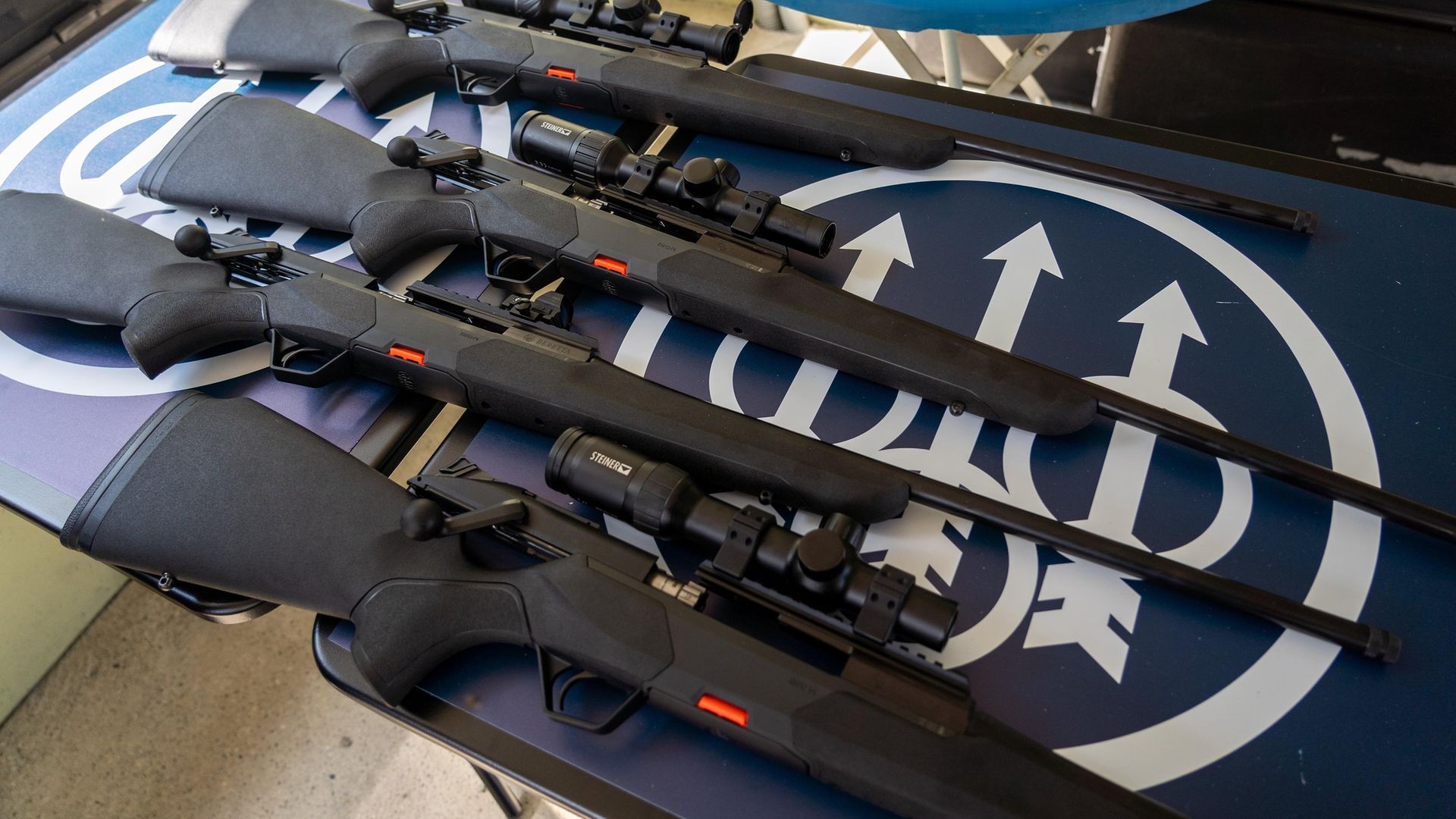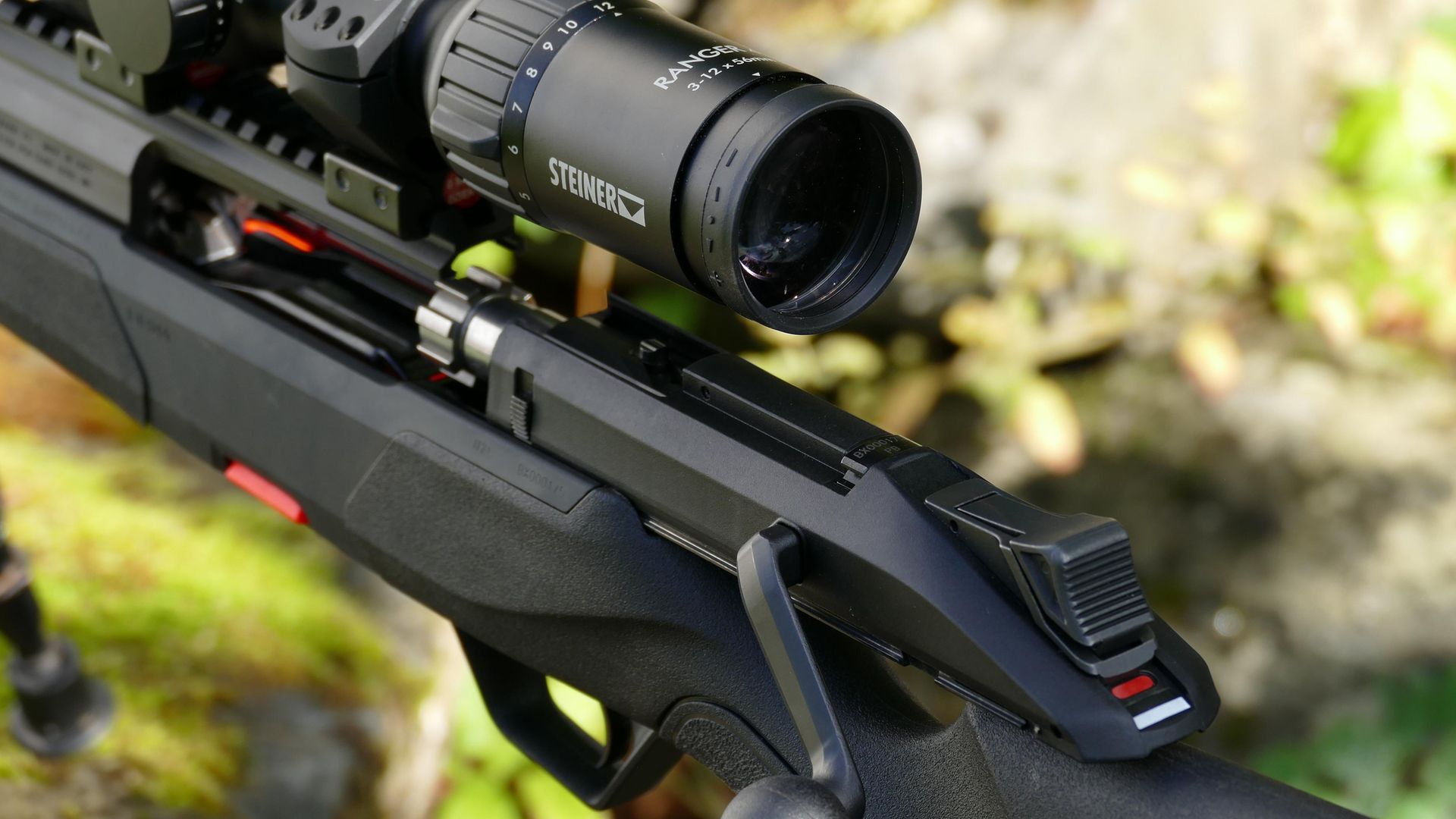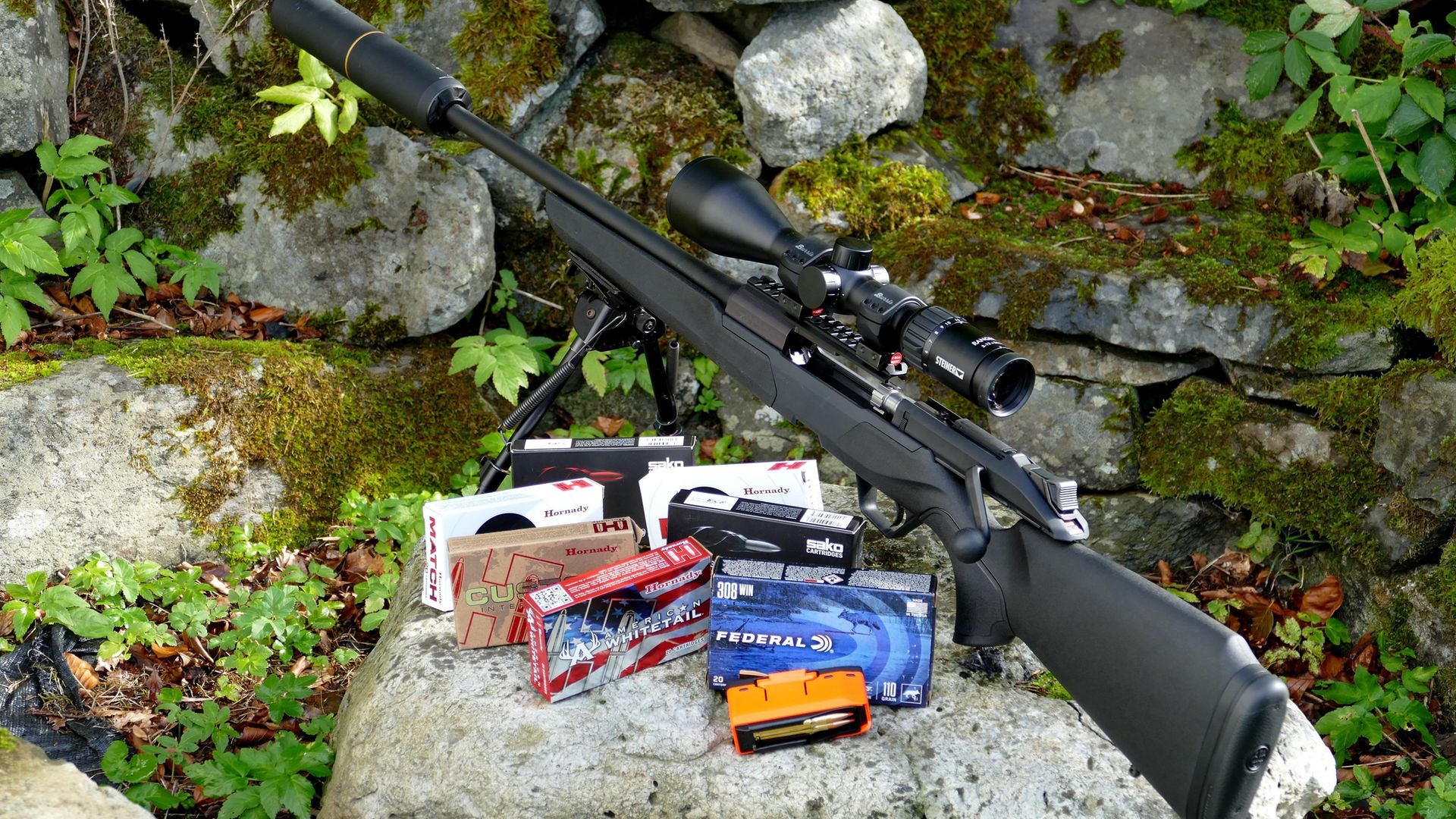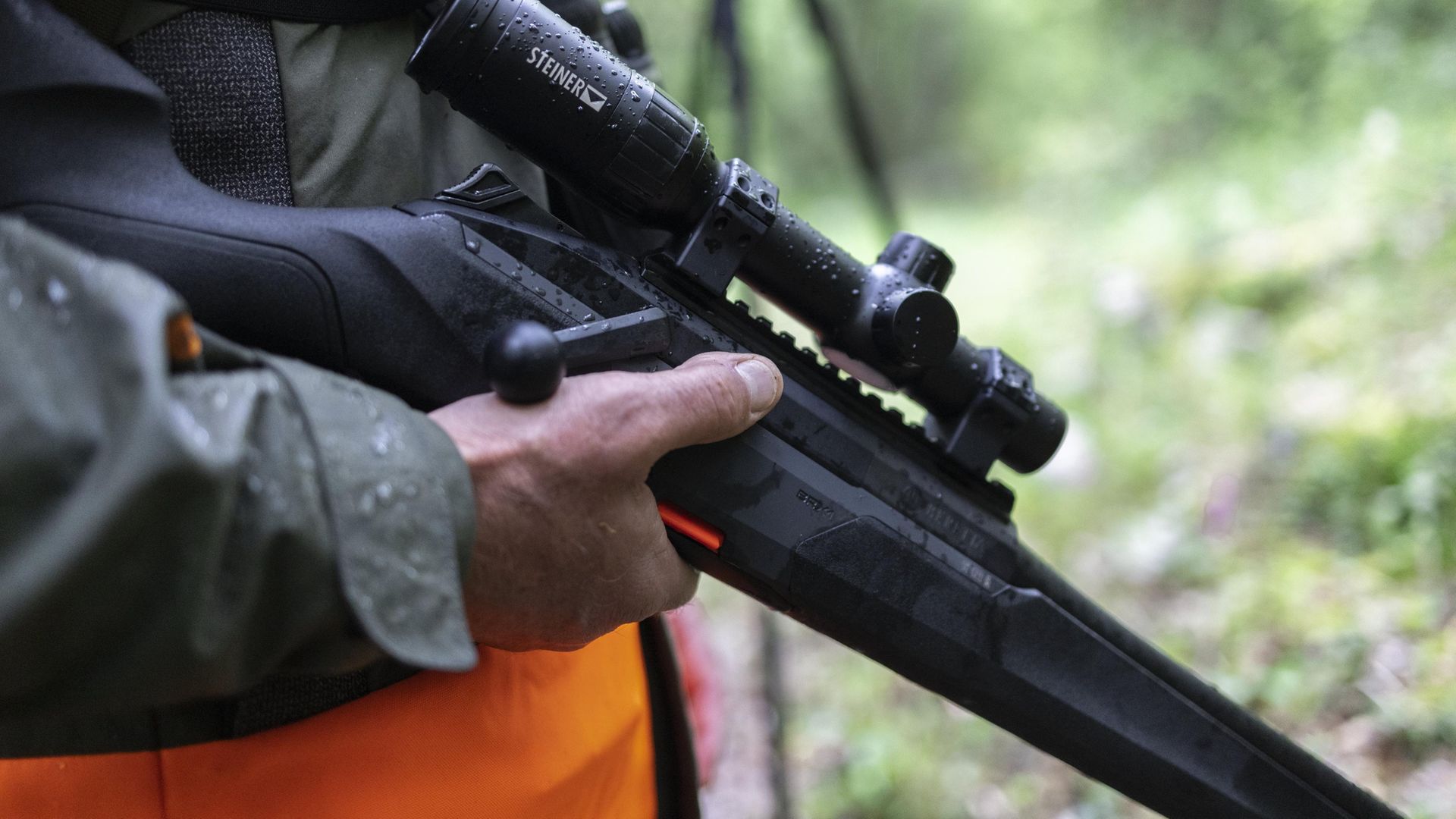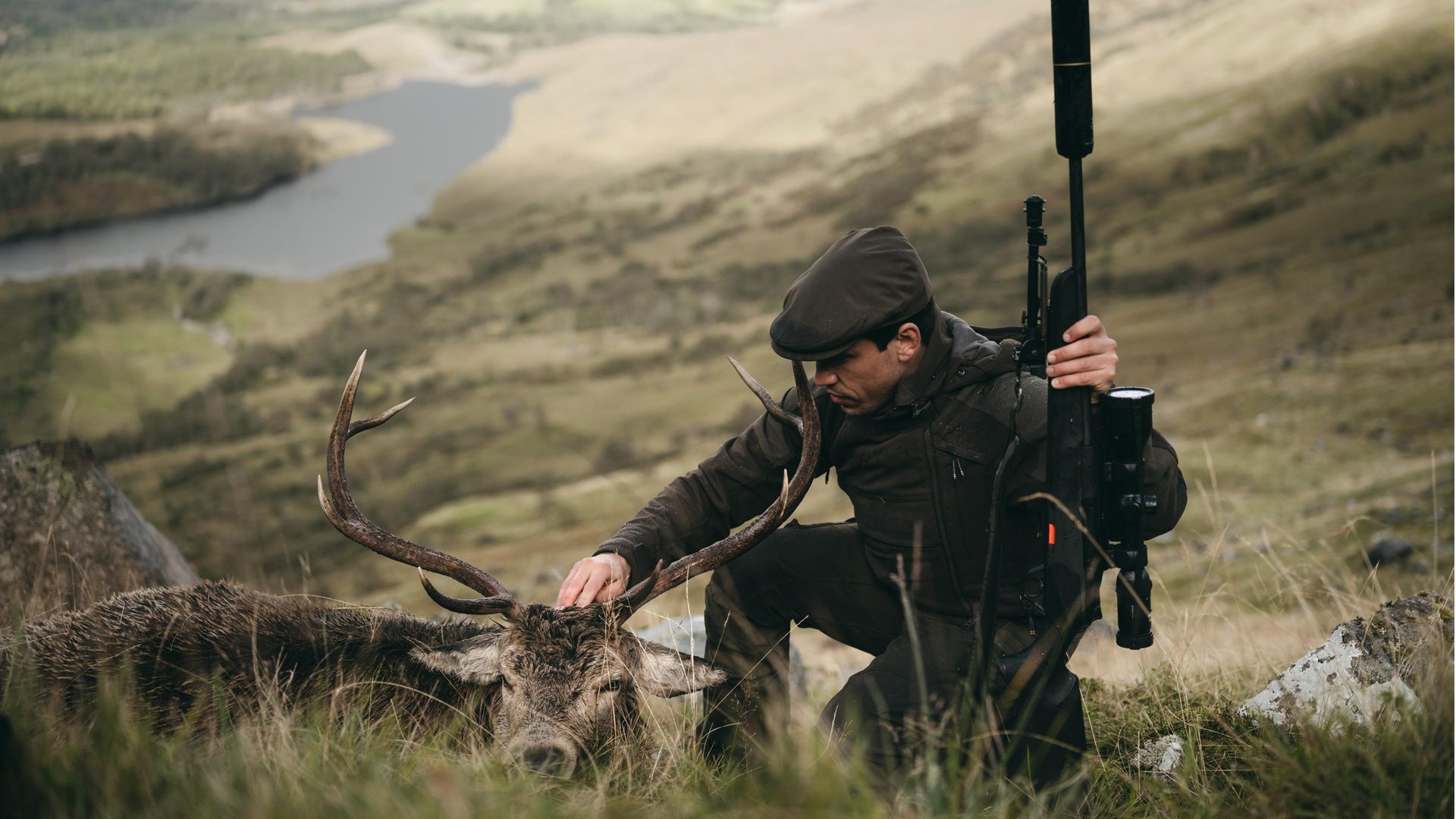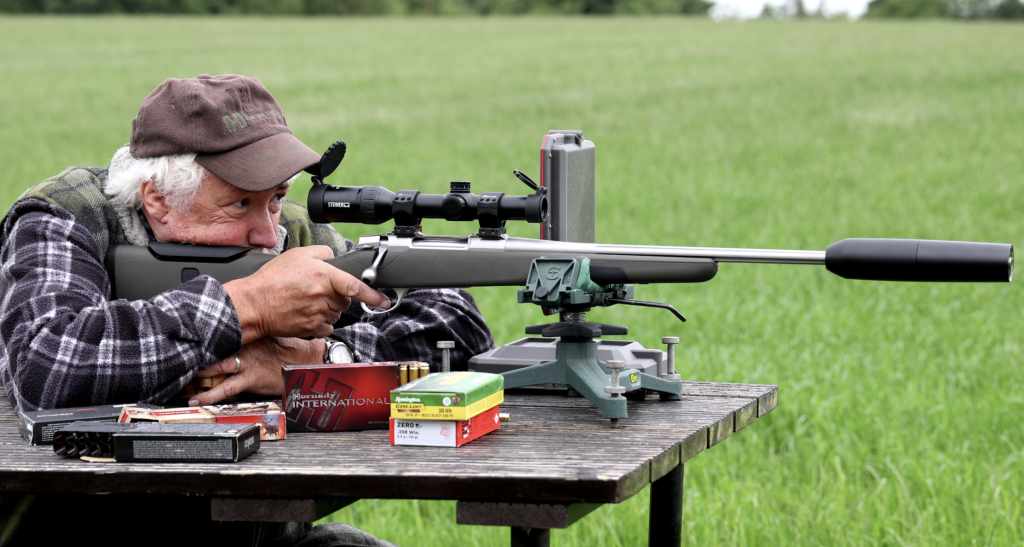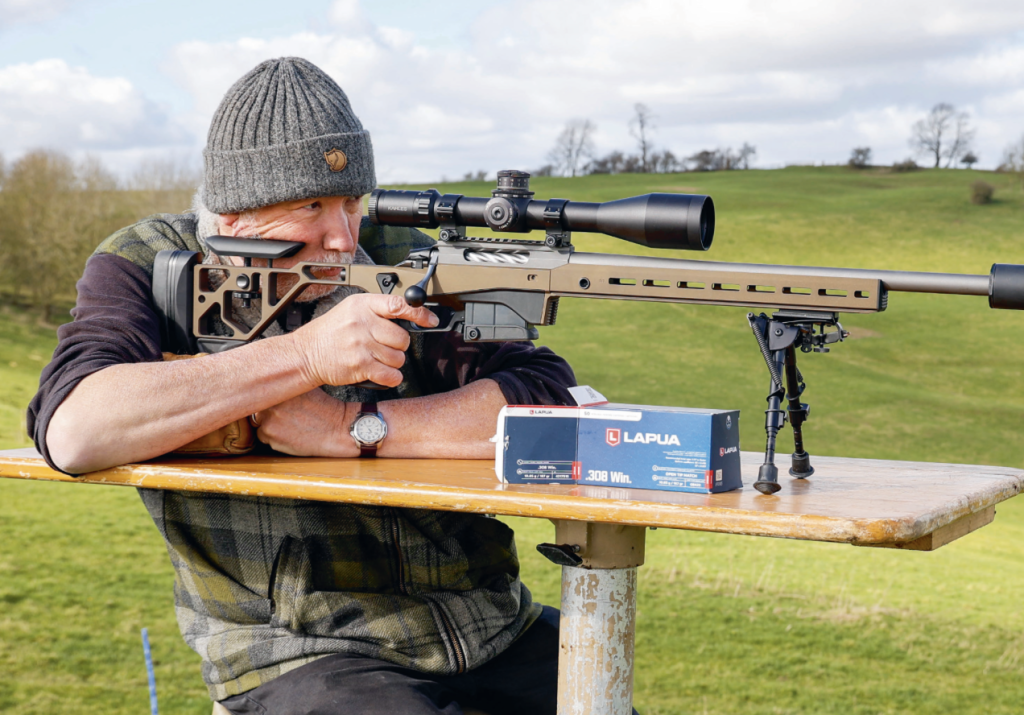Hand-built by robots: the NEW Beretta BRX1 rifle
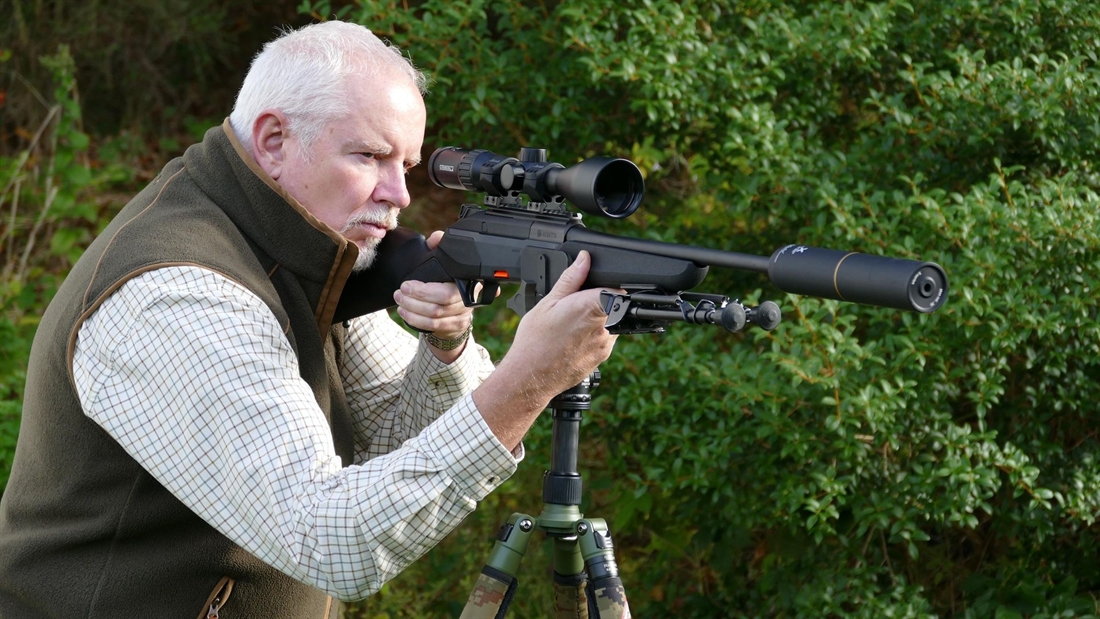
Paul Austin explores the all-new BRX1 – the first rifle to be built by Beretta, and one that ushers in a whole new era of gunmaking possibilities…
I occasionally get the odd surprise appearing in my inbox, but an invite from Beretta to a three-day trip to the Italian lakes was certainly more of a surprise than most. I thought someone must have put me on the wrong mailing list at first, but after a slightly puzzled reply it appeared there was no mistake.
It was all very intriguing. What could Beretta possibly want with a rifle guy? The three-day trip obviously meant it was something big, but it was all very hush-hush, with not even a hint of what one of the true giants of the industry was up to.
Never one to say no to a flashy press junket, I set about filling in the forms and jumping through the innumerable hoops Covid demanded of any would-be traveller at the time. Half way though the form filling and pre-flight testing I must admit I was thinking… This better be worth the effort!
A dawn flight from Manchester soon had me trundling my carry-on towards passport control in Milan, preying I hadn’t made a mess of the paperwork. All was well and I settled down in arrivals to await my partners in crime and the subsequent taxi to the aptly named Grand Hotel on the shores of Lake Garda.
Right on time a familiar face appeared as Mr Ripley, minus his trademark wellies, trotted up alongside our designated carer, GMK’s very own Imogen Waktare. A few minutes later we were loaded up and en route through the stunning Italian countryside.
On arrival we donned the ubiquitous lanyards and name tags, and it soon became clear that journalists from every corner of Europe were on hand to get a first glimpse of what was clearly going to be a whole new direction for Beretta.
The itinerary was laid out with military precision and the evening began with a short bus ride to the sprawling villa of First World War Italian warrior poet Gabriele D’Annunzio. On the deck of the cruiser Puglia, which is buried in the mountainside high above the lake, it was finally time for the big reveal.
The main event: launching the BRX1
Beretta’s senior management, including president and CEO Franco Gussalli Beretta himself, were on deck to pipe aboard the latest additional to the Beretta arsenal – the BRX1. This straight-pull high-tech centrefire is a marked departure from Beretta’s famously shotgun-centric product line, but it’s important to remember that the company is by no means a newcomer to bullet guns.
Famous as the supplier of side-arms to the US military, as well as semi-automatic machine guns and machine pistols to police and the military across the globe, not to mention owning both Sako and Tikka, they definitely have centrefire knowhow. It’s just not something most people associate with the Beretta brand.
After the fireworks and fanfares died down, we got our first look at the rifle, but it was afterwards at the pop-up fine-dining restaurant housed in a Romanesque amphitheatre, complete with a jazz quartet, that the really interesting conversations started. At these events it’s often what the hosts think your reaction is going to be that is the really telling factor.
In this case their primary concern wasn’t the mechanics, reliability or accuracy, but there was definitely concern that what turned out to be a relatively cheap rifle would be considered exactly that – ‘cheap’. However I can assure you that it isn’t.
The final flourish for the evening was an impressive floor show, with dancers leaping about the open-air stage with what can only be described as light sabres spinning and wheeling through the air to reveal the word ‘Beretta’, the famous trident logo and the all-new BRX1 branding – all conjured out of thin air by the animated light show. Beretta not only know how to build firearms – they definitely know how to put on a show as well.
The next morning it was an early start for the planned trip to the range, but before that came the official press briefing. The presentation went through the mechanics of the BRX1 along with the back story, which told of an initial concept some six or seven years ago that turned into a full-time development project that ran for five years. Last, but no means least, we came to the price – €1,549.
I’ll be honest, I was genuinely shocked. After the previous night’s introduction and after only minimal handling I had very conservatively opted for ‘€2K and change’ as my guesstimated asking price. After the presentation there were a few mumblings about why Beretta had launched a rifle directly in line with the Tikka T3x in terms of price, but as I’m sure you’re well aware that also puts Howa, Bergara, Mauser and many others firmly in the sights of the BRX1.
The next big question was how have they done it? A straight-pull with switchable barrels and a lot of fancy tech for €1,500? The answer is simple and the inspiration for the headline. The BRX1 has no hand finishing whatsoever. The parts are manufactured, it’s assembled and it’s shipped. That’s it! One of the key goals was to launch a straight-pull at the $/€1,500 price point. According to Beretta the only reason they can offer the rifle at this price is their ability to cut out hand finishing, thanks entirely to their total faith in the precision of their latest computer-controlled tech, which in the end is what makes the BRX1 possible.
Beretta have been trading for almost 500 years, but it’s a very young company in terms outlook and engineering, with the mantra for the organisation summed up in a single word – digital. That’s where they see their future, and indeed their profit margins, moving forward.
Shooting the BRX1
Bidding farewell to lake Garda, we were on the bus and heading for the range. On arrival three groups were formed, each having a separate station. Mark Ripley and I started off in the presentation area, which offered some long-awaited hands-on/tinkering time with the rifle plus the opportunity to quiz the engineers on some of the finer points of the design.
The next stop was the range and a chance to get behind the BRX1 for the first time and loose a few rounds. The choices being .308, .30-06 and .300 Win mag, driven game being the ‘bread and butter’ for this lightweight 3.3kg rifle. For any straight-pull these initial calibres make perfect sense but we Brits might well appreciate the 6.5 Creedmoor variant due to arrive first quarter of 2022. The engineers tell me smaller calibres such .223 are an option, but I suspect that will be a quite a long way off.
All three calibres were certainly quite lively on this lightweight rifle, especially the monstrous .300 Win mag, but the accuracy was there and my initial concerns about the unusual cantilever Picatinny rail were eased, as the BRX1 coped well with even the heavy-recoiling .300 Win mag.
After the range it was off to try our hand at driven boar, which was set up as a competition shoot and certainly generating a lot of excitement from the German contingent. Not really knowing what we were doing, and being the gentlemen we are, Mark and I elected to let Imogen go first. Loaded with 200gr .308 subsonics, the rifle shot very softly and proved to be the perfect setup for driven boar.
Next up was Mr Ripley, who not surprisingly accounted for himself very admirably, considering this was his first attempt. At this point I’d like to announce my retirement from competition shooting, not that I’ve ever done any. However, with a lifetime goal achieved with the spanking of Mr Ripley in the driven boar competition I can comfortably retire at the top of my game!
Yes, admittedly, Mark can famously nobble bunnies at 900 yards, a feat that I would need a howitzer to match, but every dog has his day and this one was mine! Living up to his reputation as a consummate gentleman, Mark did nothing more than raise an eyebrow along with a wry smile as both my arms headed skyward in a salute to my own stuffiness when quizzed about the result by the Beretta top brass.
Then we were back on the bus and off to a new hotel, and it was time to make a first visit to the spiritual home of Beretta – Gardone Val Trompia. At the end of a steep-sided valley sits possibly the worst location imaginable for a major industrial facility, but here’s where it all began and, much to their credit, it’s here that Beretta still calls home.
Yet another lavish meal and a tour of the factory, and that underlying blend of old and new is reaffirmed. Gleaming labs and ultra-high-tech testing facilities sit alongside artisan gunsmiths adding the finishing touches to high-end, high-priced shotguns. But down on the factory floor there’s still that reassuring odour of oil and engineering.
The final day of our visit and it’s back to the factory as the Beretta marketing machine pulls out all the stops to reassure the assembled hacks that it’s the ultimate in high-tech engineering that’s the driving force behind the BRX1 and its surprisingly affordable asking price.
Q-Sun machines squeeze weeks of exposure from the elements into days, and rifles and components are stress tested to destruction, with over 100,000 rounds through the BRX1 during development. Calibration machines measure in microscopic increments to ensure that tolerances are met by the state-of-the-art CNC machines, while robotic arms move and mill the components. It’s all very impressive and it’s all very Beretta, but now it’s time to take a closer look at the end result.
The BRX1: overview
After a weekend back in Blighty my demo BRX1 arrived, complete with a QR coded box to download the manual, sign up for an extended warranty and to pull up the accuracy test for that specific rifle.
Working from back to front, we’ll start with the Extralight butt pad and spacers, which are the same as those used on some of Beretta’s shotguns. The pad itself is medium-firm and consistent from toe to heel and more than adequate for a centrefire, with nice texturing that holds well in the shoulder and finished off with the Beretta logo.
As standard the rifle ships with one spacer in place but no spares, delivering an overall length of pull of 14.3″, which is a tiny bit short for yours truly but would be ideal for most. Sharing of tech is something of a recurring theme throughout the rifle, with the polymers used to create the stock originally being formulated for the defence division of the company, with a similar lineage seen in the bolt and bolt carrier design as well as the trigger group.
The stock itself does sound a little hollow around the butt area but I didn’t experience any resonance or unpleasant vibration through recoil. Moving forward through the action and on to the forend, it’s extremely dense and stiff. There’s a slight textured effect across the entire surface, which is enhanced at key locations such as the pistol grip and on the underside of the forend.
The pistol grip is detachable and you can expect to see replacement grip options coming soon in the style of the Tikka T3x range, but the stock unit is all that will be available at launch. That’s not a particular hardship as the grip is quite slim but is nicely racked in the style of a classic sporter with wrap-around or thumb up equally comfortable in this shamelessly ambidextrous design. With 3¼” from the throat of the grip to the slim and smooth trigger blade, your finger falls nicely into position.
The trigger itself is good. There’s a very slight amount of creep but it’s predictable, breaking consistently at the desired weight. Overall the ergonomics of the grip, reach to the trigger, and the trigger itself have been nicely implemented. The polymer trigger group can be removed from the stock entirely and replaced or tweaked by the shooter. Once free of the stock you can select between three trigger weights ranging from 900g (1.98lb) to 1,500g (3.30lb), then simply pop it back in and you’re good to go. I stuck with the factory weight, which was idea for hunting.
Moving forward, we arrive at the sizeable magazine and associate mag well. The mag design is one of the key styling features of the rifle, with its bright orange walls, which I suspect will be a Marmite feature for many. The flashes of orange either side once installed are actually the press release buttons, both of which need to be squeezed simultaneously to release the mag. It’s a simple system but it works and there’s certainly very little chance of misplacing this very luminous mag out in the field.
The mag is quite plasticky but I have had no issues in terms of functionality or failures to feed. It worked flawlessly. It accommodates five rounds of .308 stacked in two columns prior to entry into the chamber. If nothing else, it certainly adds a splash of colour alongside the dark grey polymer of the stock, and blued steel of the barrel and bolt carrier, which in turn offers a nice accent to the lighter grey action and similarly toned safety. You can also feed the magazine in situ or simply drop rounds into the action and close the bolt carrier. I had no issues chambering rounds regardless of the method employed.
The forend is fairly narrow but reasonably deep and nicely scalloped to accept extended fingers without risk of contacting the barrel. At 22″ the barrel itself is slightly longer than the UK average, but with larger calibres I think that’s a wise move to maximise both powder burn and bullet speed.
It’s a slim, lightweight cold hammer-forged barrel with a 1 in 11 twist, 30mm at the reinforce and a gradual taper down to 15mm where it meets the neatly cut M14 thread for a moderator. A thread cover is supplied but GMK also included a superb .30 cal Stalon X mod as part of the test package, which went straight on the rifle during unboxing.
The stock is extremely stiff throughout with the forend, having additional latticed internal reinforcement, so there’s zero chance of contacting the free-floating barrel in any shooting position or when loading a bipod. There are sling studs front and back as you’d expect, but in terms of the basics that’s about it.
BRX1 innovative design features: where the fun starts!
As you’ve probably guessed, it’s the action that holds a lot of the innovation in this straight-pull that clearly likes to do things a little differently. Yank the bolt handle and the bolt carrier disengages and slides back effortlessly. There’s a fair amount of travel and I’d suggest the standard 14.3″ LOP as the minimum for anyone who wants to avoid tickling their nose on occasion.
Racking of the bolt is silky smooth and blisteringly fast when needed; no complaints at all in terms of bolt handling or speed. The bolt itself is an eight-lug design that rotates into the abutments as the action closes, locking the breach. For the planned magnum calibres there’s a 16-lug design using two rows of lugs that operate on the same principle.
In the pictures you’ll notice the bolt handle is on the left, but this is a completely ambidextrous rifle that can be switched from right to left in seconds, along with the ejection of spent brass. To swap sides you simply lift a small slider on the left of the bolt carrier and it can be slid straight back.
Next depress a small plunger that sits in an S-shaped groove on the carrier, which provides the rotation of the bolt and lugs into the closed position. Then just slide out the bolt. The head of the bolt can then be slid out, rotated and replaced, instantly swapping ejection from left to right, or vice versa.
To swap the bolt handle you just flip the bolt carrier over, depress a small silver button with a screw driver or Allen key, and the handle just slides out of the carrier. Turn it around and pop it back into the other side. Slide the bolt back into the carrier and then slot the whole lot back on the gun and you’re done. A right to a left-hander in under 30 seconds. If you want you can even mix and match with the handle on the left and ejection to the right, or any combination you like.
The bolt handle goes straight through the bolt carrier, connecting with it on both sides, as a result the force of racking the bolt is applied uniformly, so there’s no stuttering or lateral force applied. There’s a tiny bit of movement in the handle itself, as it’s essentially free floating, but that has no effect in terms of performance and importantly there’s no rattle or noise when you’re handling the rifle. It’s an ingenious system and a godsend for lefties like me.
The next party trick is to swap the barrel. I only had the one but the principle remains the same. Pull the bolt back, loosen the two captured action screws beneath the forend (with the supplied tool), and the barrel and Picatinny rail, along with any attached optic, just lifts away. Grab another barrel, presumably with a pre-zeroed scope attached, and screw it into place. As the scope never leaves the barrel, any loss of zero should be minimal and most likely non-existent. If it’s a totally different calibre you may need to swap the bolt head and mag, but that only takes a moment.
So you have a few choices – the same calibre with day and night optics attached, or completely different calibres. If the former it would probably be cheaper to go with quick release mounts on both scopes but it’s nevertheless an option.
With the barrel lifted away, the V-shaped bedding block is revealed, along with the free-floating recoil lug, which sits snugly into a recessed slot. The V is mirrored by the underside of the barrel, with a matching recess ready to accept the aforementioned lug.
Perhaps the one element that raised an eyebrow at first was the method of scope attachment. At first glance the cantilever design does look a little precarious but on closer inspection it’s clearly well thought out with what would typically be the front action bridge far deeper than normal, perhaps 2.5 to 3 times longer than a standard scope mounting point.
The action is milled out of a single piece of steel with a continuous spur reaching back over the bolt carrier. It’s here that the power of modern CNC machines clearly comes into play. This spur goes back roughly two-thirds of the way beneath the Picatinny rail above, leaving an overhang of 5.6cm that is bridged at the rear as the action is closed.
It’s certainly different, but it appears to work and Beretta’s selection of fairly heavy hitting calibres shows they’re confident in the new design, especially when you consider that the planned magnum calibres will all employ exactly the same system.
The final element to explore is the chunky tang safety at the rear of the bolt carrier. I’ll be honest, the safety system isn’t quite as polished as the rest of the rifle, being quite stiff to operate and requiring a bit of effort to engage and disengage.
But it definitely works and to be honest when rough shooting and climbing gates and fences it would be very welcome, as there’s absolutely no chance whatsoever you could disengage this safety accidentally. It’s a very safe rifle but the safety mechanism itself feels a bit agricultural compared with its more expensive peers. Would it put me off buying the BRX1? No, it wouldn’t. It pretty much reaffirms what this rifle is all about. It’s a field gun, a hunting weapon, not a bench-rest rifle.
There are three stages on offer. Stage one, safe with the bolt locked; stage two, safe with the bolt free; and finally all the way forward to fire. In stage one it’s all the way back, stage two reveals a white flash and then a final red indicator when pushed all the way forward and ready to fire.
BRX1: Bench test
I didn’t have time to really bed the rifle in before testing, so I’ve taken a slightly different route than normal when it comes to group size measurement. I was lucky enough to take the BRX1 down to Minsterley ranges in Shropshire for the tests. Concrete benches, a lovely 100 yard range and perfect weather conditions, so there were no excuses, other than my limited talents.
It was a brand new barrel, but time was short, with a queue of would-be reviewers waiting in the wings to receive the rifle, so I elected to shoot 5 shot groups, deducting a flyer or worst placed shot from each group and then measuring the four remaining. With 7 factory loads to try, and adding in some cooling time for the new lightweight barrel, it seemed the fairest method.
To be honest the flyers were minimal and probably down to yours truely, although the barrel did not seem too keen on Hornady Custom or Match ammo, however it loved Hornady’s American whitetail, which was only pipped by the superb cloverleaf grouping of Federal 110gr, which won the day, closely followed (not surprisingly) by the two Sako offerings.
BRX1 groupings with different bullets
|
Bullet |
Group size (“) |
|
American |
0.61 |
|
Hornady |
1.12 |
|
Hornady |
1.18 |
|
Hornady |
1.32 |
|
Federal |
0.51 |
|
Sako |
0.70 |
|
Sako |
0.75 |
Final thoughts on the BRX1
I think the best test results confirm this rifle can certainly shoot, and in my opinion, it would make for a great field gun that can still hold its own at the range when needed. Is it a cheap Blaser? No, it’s not, it shares many similarities. It’s blisteringly fast but it doesn’t have quite the finesse, fit and finish of the R8 but it would be crazy to expect that from a rifle that retails at a fraction of the price.
Like most straight-pulls it’s all about speed and that’s certainly the case with the BRX1. It’s not easy to sneak a round into the chamber quietly but the rock-solid (if slightly industrial) safety means I’d have no qualms about chambering a round in advance. Some may see it as a budget Blaser but the BRX1 is a rifle in its own right, a real working gun, full of innovation, accurate and amazingly good value.
The trigger is a typical example of what separates the two. The BRX1 trigger is good, the Blaser trigger is the best off-the-shelf trigger money can buy. In a fast-shooting situation would one put more in the bag than the other, to be honest I doubt it, they’re both blisteringly fast and I’m sure the 6.5 Creedmoor variant will find its way into many a UK gun cabinet early next year.
Crucially the BRX1 at a price point means you don’t necessarily need to sell something else to buy one. If you’ve always fancied a straight-pull but couldn’t stomach the investment in a Blaser of a Merkel now you have an alternative and a damn good one!
CONTACTS
Rifle: Beretta BRX1
Supplier: GMK
RRP: £1500
Ammunition supplied by GMK
- Federal 110g
- Sako Gamehead 113g
- Sako Racehead 164g
Ammunition supplied by Edgar Brothers
- Hornady American Whitetail 150g
- Hornady custom 180gr
- Hornady match 155gr
- Hornady match 168g
Related Articles
Get the latest news delivered direct to your door
Subscribe to Rifle Shooter
Elevate your shooting experience with a subscription to Rifle Shooter magazine, the UK’s premier publication for dedicated rifle enthusiasts.
Whether you’re a seasoned shot or new to the sport, Rifle Shooter delivers expert insights, in-depth gear reviews and invaluable techniques to enhance your skills. Each bi-monthly issue brings you the latest in deer stalking, foxing, long-range shooting, and international hunting adventures, all crafted by leading experts from Britain and around the world.
By subscribing, you’ll not only save on the retail price but also gain exclusive access to £2 million Public Liability Insurance, covering recreational and professional use of shotguns, rifles, and airguns.
Don’t miss out on the opportunity to join a community of passionate shooters and stay at the forefront of rifle technology and technique.



